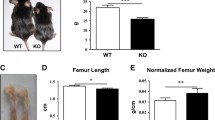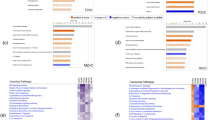Abstract
Based on developmental fate and function, cartilage tissue is broadly classified into transient cartilage (e.g. growth plate, GP) and permanent cartilage (e.g. articular cartilage, AC). The former eventually disappears and is replaced by bone during the endochondral ossification process, whereas the latter retains its permanency. Osteo(chondro)clasts, multinucleated giant cells of the monocyte/macrophage lineage, are selectively induced in the GP during endochondral ossification and play central roles in the resorption of cartilagenous matrices. The aim of this study was to investigate the factors determining the GP-specific recruitment of osteo(chondro)clasts. We especially focused on the expression pattern of the receptor activator of NF-κB ligand (RANKL), an essential factor for osteo(chondro)clast differentiation, and on that of epigenetic and transcriptional factors affecting RANKL gene expression. Knee joints of male BALB/c mice aged 8 weeks were dissected and subjected to immunohistochemical analysis using anti-RANKL, Runx2, Dlx5 and Msx2 antibodies. The methylation status of the mouse RANKL gene promoter in both the GP and the AC was analyzed by sodium bisulfite mapping using microdissected mouse tissue. The expression of BMP-2, -3, -4, -6 and type X collagen mRNA was examined by in situ hybridization (ISH). At the boundary between the calcifying cartilage and the hypertrophic chondrocytes of the GP, RANKL-expressing chondrocytes overlapped those expressing Runx2, Dlx5 and Msx2, near numerous osteo(chondro)clasts. Although similar BMP-2 and -4 expression was observed in chondrocytes in both the GP and the AC as well as in maturing osteoblasts, a rather restricted BMP-6 expression pattern was observed in resting and proliferating chondrocytes in the GP. On the other hand, sodium bisulfite mapping showed that mostly non-CpG methylation was similarly scattered in a non-specific manner in chondrocytes in the GP and the AC. Taken together with the fact that putative Runx2 binding elements are located in the RANKL promoter, our data suggest that Runx2, an essential transcription factor for skeletal development, is also a key regulator of RANKL expression in chondrocytes in the GP. Furthermore, a selective and sequential expression of a subset of BMP and of transcription factors may define the expression pattern of RANKL through Runx2.





Similar content being viewed by others
References
Banerjee C, McCabe LR, Choi JY, Hiebert SW, Stein JL, Stein GS, Lian JB (1997) Runt homology domain proteins in osteoblast differentiation: AML3/CBFA1 is a major component of a bone-specific complex. J Cell Biochem 66:1–8
Ducy P, Zhang R, Geoffroy V, Ridall AL, Karsenty G (1997) Osf2/Cbfa1: a transcriptional activator of osteoblast differentiation. Cell 89:747–754
Elima K, Eerola I, Rosati R, Metsaranta M, Garofalo S, Perala M, De Crombrugghe B, Vuorio E (1993) The mouse collagen X gene: complete nucleotide sequence, exon structure and expression pattern. Biochem J 289(Pt 1):247–253
Enomoto H, Shiojiri S, Hoshi K, Furuichi T, Fukuyama R, Yoshida CA, Kanatani N, Nakamura R, Mizuno A, Zanma A, Yano K, Yasuda H, Higashio K, Takada K, Komori T (2003) Induction of osteoclast differentiation by Runx2 through receptor activator of nuclear factor-kappa B ligand (RANKL) and osteoprotegerin regulation and partial rescue of osteoclastogenesis in Runx2-/- mice by RANKL transgene. J Biol Chem 278:23971–23977
Ferrari D, Kosher RA (2002) Dlx5 is a positive regulator of chondrocyte differentiation during endochondral ossification. Dev Biol 252:257–270
Geoffroy V, Kneissel M, Fournier B, Boyde A, Matthias P (2002) High bone resorption in adult aging transgenic mice overexpressing cbfa1/runx2 in cells of the osteoblastic lineage. Mol Cell Biol 22:6222–6233
Gerber HP, Vu TH, Ryan AM, Kowalski J, Werb Z, Ferrara N (1999) VEGF couples hypertrophic cartilage remodeling, ossification and angiogenesis during endochondral bone formation. Nat Med 5:623–628
Hassan MQ, Javed A, Morasso MI, Karlin J, Montecino M, van Wijnen AJ, Stein GS, Stein JL, Lian JB (2004) Dlx3 transcriptional regulation of osteoblast differentiation: temporal recruitment of Msx2, Dlx3, and Dlx5 homeodomain proteins to chromatin of the osteocalcin gene. Mol Cell Biol 24:9248–9261
Himeno M, Enomoto H, Liu W, Ishizeki K, Nomura S, Kitamura Y, Komori T (2002) Impaired vascular invasion of Cbfa1-deficient cartilage engrafted in the spleen. J Bone Miner Res 17:1297–1305
Holmen SL, Zylstra CR, Mukherjee A, Sigler RE, Faugere MC, Bouxsein ML, Deng L, Clemens TL, Williams BO (2005) Essential role of β-catenin in postnatal bone acquisition. J Biol Chem 280:21162–21168
Inada M, Yasui T, Nomura S, Miyake S, Deguchi K, Himeno M, Sato M, Yamagiwa H, Kimura T, Yasui N, Ochi T, Endo N, Kitamura Y, Kishimoto T, Komori T (1999) Maturational disturbance of chondrocytes in Cbfa1-deficient mice. Dev Dyn 214:279–290
Ito Y, Miyazono K (2003) RUNX transcription factors as key targets of TGF-β superfamily signaling. Curr Opin Genet Dev 13:43–47
Kawana F, Sasaki T (2003) Osteoclast differentiation and characteristic trabecular bone formation during growth plate destruction in osteoprotegerin-deficient mice. J Electron Microsc (Tokyo) 52:515–525
Kim IS, Otto F, Zabel B, Mundlos S (1999) Regulation of chondrocyte differentiation by Cbfa1. Mech Dev 80:159–170
Kim YJ, Lee MH, Wozney JM, Cho JY, Ryoo HM (2004) Bone morphogenetic protein-2-induced alkaline phosphatase expression is stimulated by Dlx5 and repressed by Msx2. J Biol Chem 279:50773–50780
Kitazawa R, Kitazawa S, Kashimoto H, Maeda S (1998) Expression of bone morphogenetic proteins (BMPs) in fractured mouse bone tissue: in situ hybridization with polymerase chain reaction (PCR)-derived antisense DNA probe. Acta Histochem Cytochem 31:231–236
Kitazawa R, Kitazawa S, Maeda S (1999a) Promoter structure of mouse RANKL/TRANCE/OPGL/ODF gene. Biochim Biophys Acta 1445:134–141
Kitazawa R, Kitazawa S (2002a) Vitamin D3 augments osteoclastogenesis via vitamin D-responsive element of mouse RANKL gene promoter. Biochem Biophys Res Commun 290:650–655
Kitazawa S, Kitazawa R (2002b) Epigenetic control of mouse receptor activator of NF-kappa B ligand gene expression. Biochem Biophys Res Commun 293:126–131
Kitazawa S, Kitazawa R, Maeda S (1999b) In situ hybridization with polymerase chain reaction-derived single-stranded DNA probe and S1 nuclease. Histochem Cell Biol 111:7–12
Kitazawa S, Kitazawa R, Maeda S (2000) Identification of methylated cytosine from archival formalin-fixed paraffin-embedded specimens. Lab Invest 80:275–276
Komori T (2000) A fundamental transcription factor for bone and cartilage. Biochem Biophys Res Commun 276:813–816
Komori T, Yagi H, Nomura S, Yamaguchi A, Sasaki K, Deguchi K, Shimizu Y, Bronson RT, Gao YH, Inada M, Sato M, Okamoto R, Kitamura Y, Yoshiki S, Kishimoto T (1997) Targeted disruption of Cbfa1 results in a complete lack of bone formation owing to maturational arrest of osteoblasts. Cell 89:755–764
Kuboki T, Kanyama M, Nakanishi T, Akiyama K, Nawachi K, Yatani H, Yamashita K, Takano-Yamamoto T, Takigawa M (2003) Cbfa1/Runx2 gene expression in articular chondrocytes of the mice temporomandibular and knee joints in vivo. Arch Oral Biol 48:519–525
Lee MH, Kim YJ, Kim HJ, Park HD, Kang AR, Kyung HM, Sung JH, Wozney JM, Ryoo HM (2003) BMP-2-induced Runx2 expression is mediated by Dlx5, and TGF-beta 1 opposes the BMP-2-induced osteoblast differentiation by suppression of Dlx5 expression. J Biol Chem 278:34387–34394
Miyama K, Yamada G, Yamamoto TS, Takagi C, Miyado K, Sakai M, Ueno N, Shibuya H (1999) A BMP-inducible gene, dlx5, regulates osteoblast differentiation and mesoderm induction. Dev Biol 208:123–133
Mori H, Kitazawa R, Mizuki S, Nose M, Maeda S, Kitazawa S (2002) RANK ligand, RANK, and OPG expression in type II collagen-induced arthritis mouse. Histochem Cell Biol 117:283–292
Newberry EP, Latifi T, Towler DA (1998) Reciprocal regulation of osteocalcin transcription by the homeodomain proteins Msx2 and Dlx5. Biochemistry 37:16360–16368
O’Brien CA, Kern B, Gubrij I, Karsenty G, Manolagas SC (2002) Cbfa1 does not regulate RANKL gene activity in stromal/osteoblastic cells. Bone 30:453–462
Otto F, Lubbert M, Stock M (2003) Upstream and downstream targets of RUNX proteins. J Cell Biochem 89:9–18
Otto F, Thornell AP, Crompton T, Denzel A, Gilmour KC, Rosewell IR, Stamp GW, Beddington RS, Mundlos S, Olsen BR, Selby PB, Owen MJ (1997) Cbfa1, a candidate gene for cleidocranial dysplasia syndrome, is essential for osteoblast differentiation and bone development. Cell 89:765–771
Roca H, Phimphilai M, Gopalakrishnan R, Xiao G, Franceschi RT (2005) Cooperative Interactions between RUNX2 and Homeodomain Protein-binding Sites Are Critical for the Osteoblast-specific Expression of the Bone Sialoprotein Gene. J Biol Chem 280:30845–30855
Ryoo HM, Hoffmann HM, Beumer T, Frenkel B, Towler DA, Stein GS, Stein JL, van Wijnen AJ, Lian JB (1997) Stage-specific expression of Dlx-5 during osteoblast differentiation: involvement in regulation of osteocalcin gene expression. Mol Endocrinol 11:1681–1694
Saijo M, Kitazawa R, Nakajima M, Kurosaka M, Maeda S, Kitazawa S (2003) Heparanase mRNA expression during fracture repair in mice. Histochem Cell Biol 120:493–503
Satokata I, Ma L, Ohshima H, Bei M, Woo I, Nishizawa K, Maeda T, Takano Y, Uchiyama M, Heaney S, Peters H, Tang Z, Maxson R, Maas R (2000) Msx2 deficiency in mice causes pleiotropic defects in bone growth and ectodermal organ formation. Nat Genet 24:391–395
Serinsoz E, Bock O, Kirsch T, Haller H, Lehmann U, Kreipe H, Mengel M (2005) Compartment-specific quantitative gene expression analysis after laser microdissection from archival renal allograft biopsies. Clin Nephrol 63:193–201
Shirakabe K, Terasawa K, Miyama K, Shibuya H, Nishida E (2001) Regulation of the activity of the transcription factor Runx2 by two homeobox proteins, Msx2 and Dlx5. Genes Cells 6:851–856
Suda T, Takahashi N, Udagawa N, Jimi E, Gillespie MT, Martin TJ (1999) Modulation of osteoclast differentiation and function by the new members of the tumor necrosis factor receptor and ligand families. Endocr Rev 20:345–357
Takamoto M, Tsuji K, Yamashita T, Sasaki H, Yano T, Taketani Y, Komori T, Nifuji A, Noda M (2003) Hedgehog signaling enhances core-binding factor a1 and receptor activator of nuclear factor-kappaB ligand (RANKL) gene expression in chondrocytes. J Endocrinol 177:413–421
Ueta C, Iwamoto M, Kanatani N, Yoshida C, Liu Y, Enomoto-Iwamoto M, Ohmori T, Enomoto H, Nakata K, Takada K, Kurisu K, Komori T (2001) Skeletal malformations caused by overexpression of Cbfa1 or its dominant negative form in chondrocytes. J Cell Biol 153:87–100
Zhang H, Hu G, Wang H, Sciavolino P, Iler N, Shen MM, Abate-Shen C (1997) Heterodimerization of Msx and Dlx homeoproteins results in functional antagonism. Mol Cell Biol 17:2920–2932
Acknowledgements
This work was supported in part by a Grant-in-Aid for Scientific Research from the Ministry of Education, Culture, Sports, Science and Technology, Japan, to S.K. and R.K.. The authors thank Drs. Takeshi Kondo and Agus Darwanto for scientific contribution, and Mr. Shuichi Matsuda, Ms. Noriko Sakamoto and Ms. Kawano Yuka for excellent technical assistance.
Author information
Authors and Affiliations
Corresponding author
Rights and permissions
About this article
Cite this article
Kishimoto, K., Kitazawa, R., Kurosaka, M. et al. Expression profile of genes related to osteoclastogenesis in mouse growth plate and articular cartilage. Histochem Cell Biol 125, 593–602 (2006). https://doi.org/10.1007/s00418-005-0103-z
Accepted:
Published:
Issue Date:
DOI: https://doi.org/10.1007/s00418-005-0103-z




